杨玲 201771010133《面向对象程序设计(java)》第八周学习总结
Posted yanglinga
tags:
篇首语:本文由小常识网(cha138.com)小编为大家整理,主要介绍了杨玲 201771010133《面向对象程序设计(java)》第八周学习总结相关的知识,希望对你有一定的参考价值。
《面向对象程序设计(java)》第八周学习总结
第一部分:理论知识学习部分
1. 接口:用interface声明,是抽象方法和常量值定义的集 合。从本质上讲,接口是一种特殊的抽象类。
(1)在Java程序设计语言中,接口不是类,而是对类 的一组需求描述,由常量和一组抽象方法组成。 ? 接口中不包括变量和有具体实现的方法。
(2)接口体中包含常量定义和方法定义,接口中只进 行方法的声明,不提供方法的实现。
(3)通常接口的名字以able或ible结尾;
(4)接口中的所有常量必须是public static final,方法必须是public abstract,这是 系统默认的,不管你在定义接口时,写不写 修饰符都是一样的.
(5)接口的实现:一个类使用了某个接口,那么这个类必须实现该 接口的所有方法,即为这些方法提供方法体。一个类可以实现多个接口,接口间应该用逗号分 隔开。
(6)接口的使用:接口不能构造接口对象,但可以声明接口变量以指向一个实现了该接口的类对象。
(7)可以用instanceof检查对象是否实现了某个接口。
(8)抽象类:用abstract来声明,没有具体实例对象的类,不 能用new来创建对象。
2. 接口示例
(1)回调(callback):一种程序设计模式,在这种模 式中,可指出某个特定事件发生时程序应该采取 的动作。
(2)Comparator接口所在包: java.util.*
(3)Object类的Clone方法:当拷贝一个对象变量时,原始变量与拷贝变量 引用同一个对象。这样,改变一个变量所引用 的对象会对另一个变量产生影响。
(4)如果要创建一个对象新的copy,它的最初状态与 original一样,但以后可以各自改变状态,就需 要使用Object类的clone方法。
(5)Object.clone()方法返回一个Object对象。必须进行强 制类型转换才能得到需要的类型。
(6)浅层拷贝与深层拷贝
(7)Java中对象克隆的实现:在子类中实现Cloneable接口。
(8)在子类的clone方法中,调用super.clone()。
3. lambda表达式
(1)Java Lambda 表达式是 Java 8 引入的一个新的功能,主 要用途是提供一个函数化的语法来简化编码。
(2)Lambda 表达式的语法基本结构 (arguments) -> body
(3)有如下几种情况:
1、参数类型可推导时,不需要指定类型,如 (a) -> System.out.println(a)
2、 只有一个参数且类型可推导时,不强制写 (), 如 a -> System.out.println(a)
3、 参数指定类型时,必须有括号,如 (int a) -> System.out.println(a)
4、参数可以为空,如 () -> System.out.println(“hello”)
5、 body 需要用 {} 包含语句,当只有一条语句时 {} 可省略
4. 内部类:是定义在一个类内部的类。
(1)使用内部类的原因有以下三个: –内部类方法可以访问该类定义所在的作用域中 的数据,包括私有数据。
–内部类能够隐藏起来,不为同一包中的其他类 所见。
–想要定义一个回调函数且不想编写大量代码时, 使用匿名内部类比较便捷。
(2)内部类可以直接访问外部类的成员,包括 private成员,但是内部类的成员却不能被外部 类直接访问。
(3)内部类并非只能在类内定义,也可以在程序块内 定义局部内部类。
(4)如果构造参数的闭圆括号跟一个开花括号,表明正 在定义的就是匿名内部类。
5. 代理(Proxy)
第二部分:实验部分
1、实验名称:实验六 接口的定义与使用
2、实验目的与要求
(1) 掌握接口定义方法;
(2) 掌握实现接口类的定义要求;
(3) 掌握实现了接口类的使用要求;
(4) 掌握程序回调设计模式;
(5) 掌握Comparator接口用法;
(6) 掌握对象浅层拷贝与深层拷贝方法;
(7) 掌握Lambda表达式语法;
(8) 了解内部类的用途及语法要求。
2、实验内容和步骤
实验1: 导入第6章示例程序,测试程序并进行代码注释。
测试程序1:
编辑、编译、调试运行阅读教材214页-215页程序6-1、6-2,理解程序并分析程序运行结果;
在程序中相关代码处添加新知识的注释。
掌握接口的实现用法;
掌握内置接口Compareable的用法。
1 package interfaces; 2 3 public class Employee implements Comparable<Employee> 4 { 5 private String name; 6 private double salary; 7 8 public Employee(String name, double salary)//构造方法 9 { 10 this.name = name; 11 this.salary = salary; 12 } 13 14 public String getName()//Name属性的访问器 15 { 16 return name; 17 } 18 19 public double getSalary()//Salary属性的访问器 20 { 21 return salary; 22 } 23 24 public void raiseSalary(double byPercent)//改写工资数据的方法 25 { 26 double raise = salary * byPercent / 100; 27 salary += raise; 28 } 29 30 /** 31 * Compares employees by salary 32 * @param other another Employee object 33 * @return a negative value if this employee has a lower salary than 34 * otherObject, 0 if the salaries are the same, a positive value otherwise 35 */ 36 public int compareTo(Employee other) 37 { 38 return Double.compare(salary, other.salary);//调用pouble包装器类的compare方法 39 } 40 }
1 package interfaces; 2 3 import java.util.*; 4 5 /** 6 * This program demonstrates the use of the Comparable interface. 7 * @version 1.30 2004-02-27 8 * @author Cay Horstmann 9 */ 10 public class EmployeeSortTest 11 { 12 public static void main(String[] args) 13 { 14 Employee[] staff = new Employee[3];//创建普通数组对象 15 16 staff[0] = new Employee("Harry Hacker", 35000); 17 staff[1] = new Employee("Carl Cracker", 75000); 18 staff[2] = new Employee("Tony Tester", 38000);//生成三个实例对象 19 20 Arrays.sort(staff);//静态方法 21 22 // print out information about all Employee objects 23 for (Employee e : staff) 24 System.out.println("name=" + e.getName() + ",salary=" + e.getSalary()); 25 } 26 }
运行结果如下:
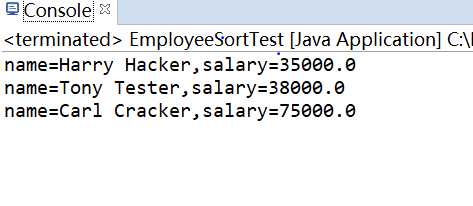
测试程序2:
l 编辑、编译、调试以下程序,结合程序运行结果理解程序;
|
interface A { double g=9.8; void show( ); } class C implements A { public void show( ) {System.out.println("g="+g);} }
class InterfaceTest { public static void main(String[ ] args) { A a=new C( ); a.show( ); System.out.println("g="+C.g); } } |
1 package InterfaceTest; 2 3 interface A 4 5 { 6 7 double g=9.8; 8 9 void show( ); 10 11 } 12 13 class C implements A 14 15 { 16 17 public void show( ) 18 19 {System.out.println("g="+g);} 20 21 } 22 23 24 25 class InterfaceTest 26 27 { 28 29 public static void main(String[ ] args) 30 31 { 32 33 A a=new C( ); 34 35 a.show( ); 36 37 System.out.println("g="+C.g); 38 39 } 40 41 }
运行结果如下:
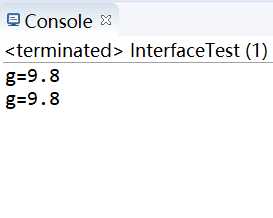
测试程序3:
l 在elipse IDE中调试运行教材223页6-3,结合程序运行结果理解程序;
l 26行、36行代码参阅224页,详细内容涉及教材12章。
l 在程序中相关代码处添加新知识的注释。
l 掌握回调程序设计模式;
1 package timer; 2 3 /** 4 @version 1.01 2015-05-12 5 @author Cay Horstmann 6 */ 7 8 import java.awt.*;//包 9 import java.awt.event.*; 10 import java.util.*; 11 import javax.swing.*; 12 import javax.swing.Timer; 13 // to resolve conflict with java.util.Timer 14 15 public class TimerTest//主类 16 { 17 public static void main(String[] args) 18 { 19 ActionListener listener = new TimePrinter();//引用 监听 20 21 // construct a timer that calls the listener 22 // once every 10 seconds 23 Timer t = new Timer(10000, listener); 24 t.start(); 25 26 JOptionPane.showMessageDialog(null, "Quit program?"); 27 System.exit(0); 28 } 29 } 30 31 class TimePrinter implements ActionListener//内置接口 用户自定义类 32 { 33 public void actionPerformed(ActionEvent event) 34 { 35 System.out.println("At the tone, the time is " + new Date()); 36 Toolkit.getDefaultToolkit().beep();//静态方法 37 } 38 }
运行结果如下:
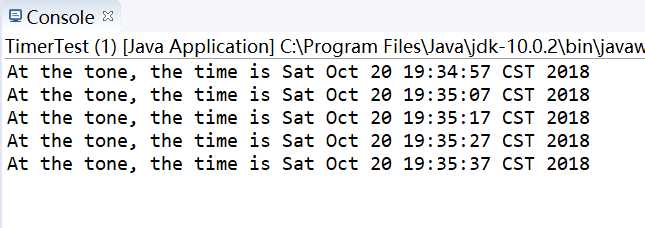
测试程序4:
l 调试运行教材229页-231页程序6-4、6-5,结合程序运行结果理解程序;
l 在程序中相关代码处添加新知识的注释。
l 掌握对象克隆实现技术;
l 掌握浅拷贝和深拷贝的差别。
1 package clone; 2 3 import java.util.Date; 4 import java.util.GregorianCalendar; 5 6 public class Employee implements Cloneable 7 { 8 private String name; 9 private double salary; 10 private Date hireDay; 11 12 public Employee(String name, double salary) 13 { 14 this.name = name; 15 this.salary = salary; 16 hireDay = new Date(); 17 } 18 19 public Employee clone() throws CloneNotSupportedException 20 { 21 // call Object.clone() 22 Employee cloned = (Employee) super.clone(); 23 24 // clone mutable fields 25 cloned.hireDay = (Date) hireDay.clone(); 26 27 return cloned; 28 } 29 30 /** 31 * Set the hire day to a given date. 32 * @param year the year of the hire day 33 * @param month the month of the hire day 34 * @param day the day of the hire day 35 */ 36 public void setHireDay(int year, int month, int day) 37 { 38 Date newHireDay = new GregorianCalendar(year, month - 1, day).getTime(); 39 40 // Example of instance field mutation 41 hireDay.setTime(newHireDay.getTime()); 42 } 43 44 public void raiseSalary(double byPercent) 45 { 46 double raise = salary * byPercent / 100; 47 salary += raise; 48 } 49 50 public String toString() 51 { 52 return "Employee[name=" + name + ",salary=" + salary + ",hireDay=" + hireDay + "]"; 53 } 54 }
1 import clone.Employee; 2 3 /** 4 * This program demonstrates cloning. 5 * @version 1.10 2002-07-01 6 * @author Cay Horstmann 7 */ 8 public class CloneTest 9 { 10 public static void main(String[] args) 11 { 12 try 13 { 14 Employee original = new Employee("John Q. Public", 50000);//Employee是一个自定义类
15 original.setHireDay(2000, 1, 1);
16 Employee copy = original.clone();
17 copy.raiseSalary(10);//原有对象不会发生变化
18 copy.setHireDay(2002, 12, 31); //更改器
19 System.out.println("original=" + original); //字符串连接
20 System.out.println("copy=" + copy);
21 }
22 catch (CloneNotSupportedException e)
23 {
24 e.printStackTrace();
25 }
26 }
27 }
运行结果如下:

实验2: 导入第6章示例程序6-6,学习Lambda表达式用法。
l 调试运行教材233页-234页程序6-6,结合程序运行结果理解程序;
l 在程序中相关代码处添加新知识的注释。
l 将27-29行代码与教材223页程序对比,将27-29行代码与此程序对比,体会Lambda表达式的优点。
1 package lambda; 2 3 import java.util.*; 4 5 import javax.swing.*; 6 import javax.swing.Timer; 7 8 /** 9 * This program demonstrates the use of lambda expressions. 10 * @version 1.0 2015-05-12 11 * @author Cay Horstmann 12 */ 13 public class LambdaTest 14 { 15 public static void main(String[] args) 16 { 17 String[] planets = new String[] { "Mercury", "Venus", "Earth", "Mars", 18 "Jupiter", "Saturn", "Uranus", "Neptune" };//定义数组planets 19 System.out.println(Arrays.toString(planets));//静态方法 20 System.out.println("Sorted in dictionary order:"); 21 Arrays.sort(planets);//Arrays.sort方法接收实验Lambda类的对象 22 System.out.println(Arrays.toString(planets)); 23 System.out.println("Sorted by length:"); 24 Arrays.sort(planets, (first, second) -> first.length() - second.length());//lambda表达式
25 System.out.println(Arrays.toString(planets)); 26 27 Timer t = new Timer(1000, event -> 28 System.out.println("The time is " + new Date()));//lambda表达式
29 t.start(); 30 31 // keep program running until user selects "Ok" 32 JOptionPane.showMessageDialog(null, "Quit program?"); 33 System.exit(0); //返回类型 34 }
运行结果如下:
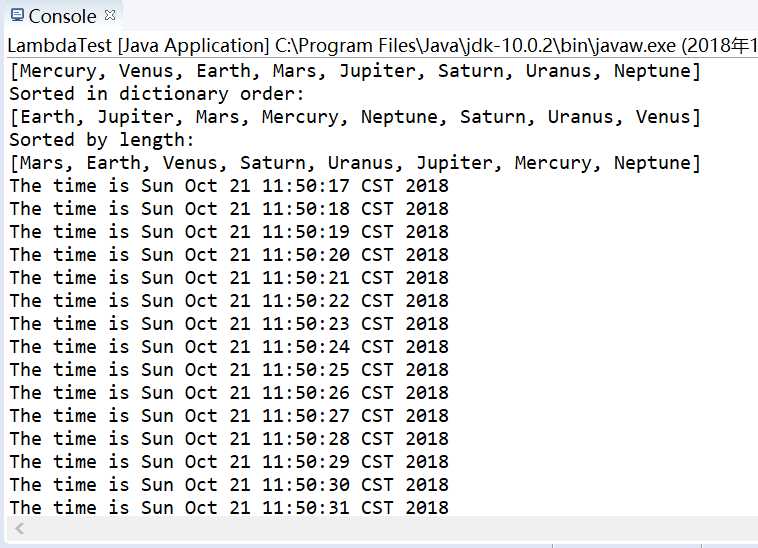
注:以下实验课后完成
实验3: 编程练习
l 编制一个程序,将身份证号.txt 中的信息读入到内存中;
l 按姓名字典序输出人员信息;
l 查询最大年龄的人员信息;
l 查询最小年龄人员信息;
l 输入你的年龄,查询身份证号.txt中年龄与你最近人的姓名、身份证号、年龄、性别和出生地;
l 查询人员中是否有你的同乡。
1 import java.io.BufferedReader; 2 import java.io.File; 3 import java.io.FileInputStream; 4 import java.io.FileNotFoundException; 5 import java.io.IOException; 6 import java.io.InputStreamReader; 7 import java.util.ArrayList; 8 import java.util.Arrays; 9 import java.util.Collections; 10 import java.util.Scanner; 11 12 public class Main{ 13 private static ArrayList<Person> Personlist; 14 public static void main(String[] args) { 15 Personlist = new ArrayList<>(); 16 Scanner scanner = new Scanner(System.in); 17 File file = new File("D:\\身份证号.txt"); 18 try { 19 FileInputStream fis = new FileInputStream(file); 20 BufferedReader in = new BufferedReader(new InputStreamReader(fis)); 21 String temp = null; 22 while ((temp = in.readLine()) != null) { 23 24 Scanner linescanner = new Scanner(temp); 25 26 linescanner.useDelimiter(" "); 27 String name = linescanner.next(); 28 String ID = linescanner.next(); 29 String sex = linescanner.next(); 30 String age = linescanner.next(); 31 String place =linescanner.nextLine(); 32 Person Person = new Person(); 33 Person.setname(name); 34 Person.setID(ID); 35 Person.setsex(sex); 36 int a = Integer.parseInt(age); 37 Person.setage(a); 38 Person.setbirthplace(place); 39 Personlist.add(Person); 40 41 } 42 } catch (FileNotFoundException e) { 43 System.out.println("查找不到信息"); 44 e.printStackTrace(); 45 } catch (IOException e) { 46 System.out.println("信息读取有误"); 47 e.printStackTrace(); 48 } 49 boolean isTrue = true; 50 while (isTrue) { 51 System.out.println("————————————————————————————————————————"); 52 System.out.println("1:按姓名字典序输出人员信息"); 53 System.out.println("2:查询最大年龄与最小年龄人员信息"); 54 System.out.println("3:按省份找同乡"); 55 System.out.println("4:输入你的年龄,查询年龄与你最近人的信息"); 56 System.out.println("5:exit"); 57 int nextInt = scanner.nextInt(); 58 switch (nextInt) { 59 case 1: 60 Collections.sort(Personlist); 61 System.out.println(Personlist.toString()); 62 break; 63 case 2: 64 65 int max=0,min=100;int j,k1 = 0,k2=0; 66 for(int i=1;i<Personlist.size();i++) 67 { 68 j=Personlist.get(i).getage(); 69 if(j>max) 70 { 71 max=j; 72 k1=i; 73 } 74 if(j<min) 75 { 76 min=j; 77 k2=i; 78 } 79 80 } 81 System.out.println("年龄最大:"+Personlist.get(k1)); 82 System.out.println("年龄最小:"+Personlist.get(k2)); 83 break; 84 case 3: 85 System.out.println("place?"); 86 String find = scanner.next(); 87 String place=find.substring(0,3); 88 String place2=find.substring(0,3); 89 for (int i = 0; i <Personlist.size(); i++) 90 { 91 if(Personlist.get(i).getbirthplace().substring(1,4).equals(place)) 92 System.out.println("maybe is "+Personlist.get(i)); 93 94 } 95 96 break; 97 case 4: 98 System.out.println("年龄:"); 99 int yourage = scanner.nextInt(); 100 int near=agenear(yourage); 101 int d_value=yourage-Personlist.get(near).getage(); 102 System.out.println(""+Personlist.get(near)); 103 /* for (int i = 0; i < Personlist.size(); i++) 104 { 105 int p=Personlist.get(i).getage()-yourage; 106 if(p<0) p=-p; 107 if(p==d_value) System.out.println(Personlist.get(i)); 108 } */ 109 break; 110 case 5: 111 isTrue = false; 112 System.out.println("退出程序!"); 113 break; 114 default: 115 System.out.println("输入有误"); 116 } 117 } 118 } 119 public static int agenear(int age) { 120 121 int j=0,min=53,d_value=0,k=0; 122 for (int i = 0; i < Personlist.size(); i++) 123 { 124 d_value=Personlist.get(i).getage()-age; 125 if(d_value<0) d_value=-d_value; 126 if (d_value<min) 127 { 128 min=d_value; 129 k=i; 130 } 131 132 } return k; 133 134 } 135 136 137 } 138 139 Main
1 public class Person implements Comparable<Person> { 2 private String name; 3 private String ID; 4 private int age; 5 private String sex; 6 private String birthplace; 7 8 public String getname() { 9 return name; 10 } 11 public void setname(String name) { 12 this.name = name; 13 } 14 public String getID() { 15 return ID; 16 } 17 public void setID(String ID) { 18 this.ID= ID; 19 } 20 public int getage() { 21 22 return age; 23 } 24 public void setage(int age) { 25 // int a = Integer.parseInt(age); 26 this.age= age; 27 } 28 public String getsex() { 29 return sex; 30 } 31 public void setsex(String sex) { 32 this.sex= sex; 33 } 34 public String getbirthplace() { 35 return birthplace; 36 } 37 public void setbirthplace(String birthplace) { 38 this.birthplace= birthplace; 39 } 40 41 public int compareTo(Person o) { 42 return this.name.compareTo(o.getname()); 43 44 } 45 46 public String toString() { 47 return name+" "+sex+" "+age+" "+ID+" "+birthplace+" "; 48 49 } 50 51 52 53 } 54 55 Person
运行结果如下:
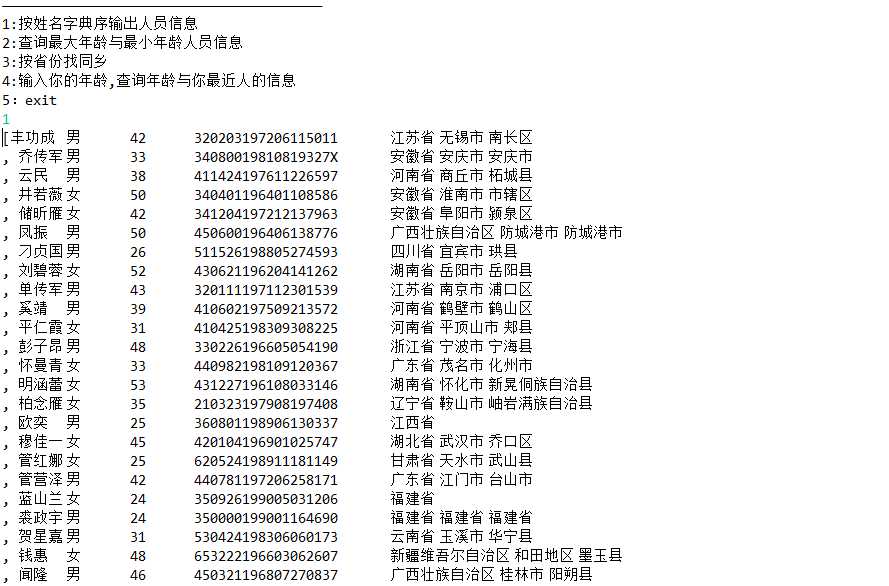
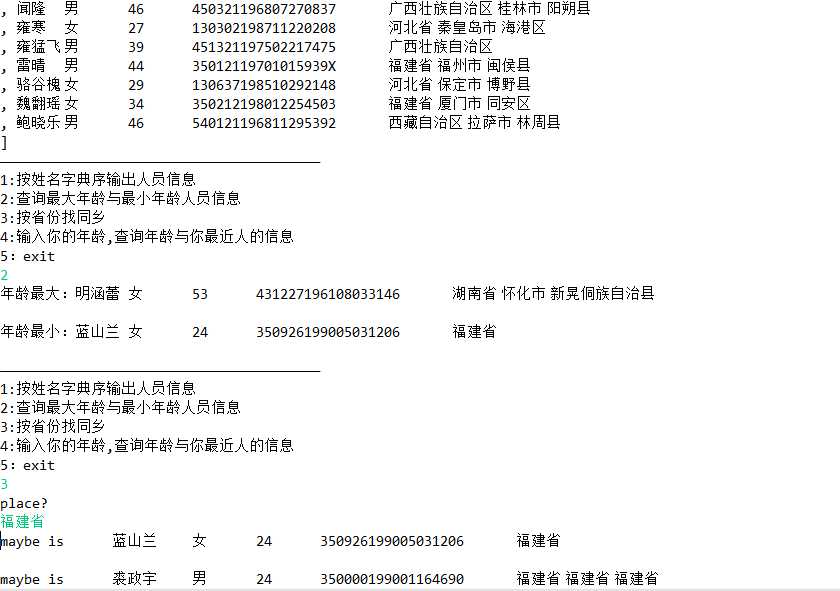

实验4:内部类语法验证实验
实验程序1:
l 编辑、调试运行教材246页-247页程序6-7,结合程序运行结果理解程序;
l 了解内部类的基本用法。
1 package innerClass; 2 3 import java.awt.*; 4 import java.awt.event.*; 5 import java.util.*; 6 import javax.swing.*; 7 import javax.swing.Timer; 8 9 /** 10 * This program demonstrates the use of inner classes. 11 * @version 1.11 2015-05-12 12 * @author Cay Horstmann 13 */ 14 public class InnerClassTest 15 { 16 public static void main(String[] args) 17 { 18 TalkingClock clock = new TalkingClock(1000, true); 19 clock.start(); 20 21 // keep program running until user selects "Ok" 22 JOptionPane.showMessageDialog(null, "Quit program?"); 23 System.exit(0); 24 } 25 } 26 27 /** 28 * A clock that prints the time in regular intervals. 29 */ 30 class TalkingClock 31 { 32 private int interval; 33 private boolean beep; 34 35 /** 36 * Constructs a talking clock 37 * @param interval the interval between messages (in milliseconds) 38 * @param beep true if the clock should beep 39 */ 40 public TalkingClock(int interval, boolean beep) 41 { 42 this.interval = interval; 43 this.beep = beep; 44 } 45 46 /** 47 * Starts the clock. 48 */ 49 public void start() 50 { 51 ActionListener listener = new TimePrinter(); 52 Timer t = new Timer(interval, listener); 53 t.start(); 54 } 55 56 public class TimePrinter implements ActionListener 57 { 58 public void actionPerformed(ActionEvent event) 59 { 60 System.out.println("At the tone, the time is " + new Date()); 61 if (beep) Toolkit.getDefaultToolkit().beep(); 62 } 63 } 64 }
运行结果如下:
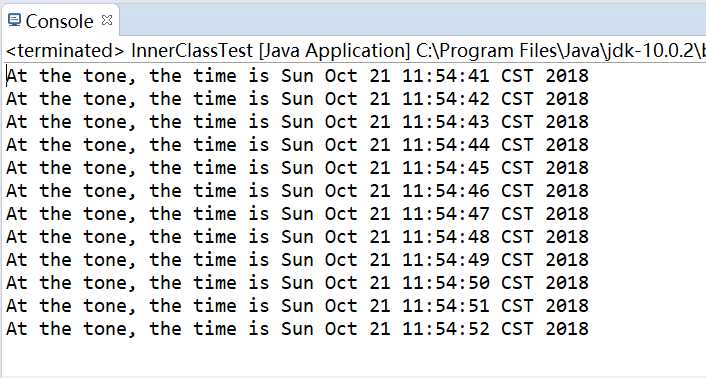
实验程序2:
l 编辑、调试运行教材254页程序6-8,结合程序运行结果理解程序;
l 了解匿名内部类的用法。
1 package anonymousInnerClass; 2 3 import java.awt.*; 4 import java.awt.event.*; 5 import java.util.*; 6 import javax.swing.*; 7 import javax.swing.Timer; 8 9 /** 10 * This program demonstrates anonymous inner classes. 11 * @version 1.11 2015-05-12 12 * @author Cay Horstmann 13 */ 14 public class AnonymousInnerClassTest 15 { 16 public static void main(String[] args) 17 { 18 TalkingClock clock = new TalkingClock(); 19 clock.start(1000, true); 20 21 // keep program running until user selects "Ok" 22 JOptionPane.showMessageDialog(null, "Quit program?"); 23 System.exit(0); 24 } 25 } 26 27 /** 28 * A clock that prints the time in regular intervals. 29 */ 30 class TalkingClock 31 { 32 /** 33 * Starts the clock. 34 * @param interval the interval between messages (in milliseconds) 35 * @param beep true if the clock should beep 36 */ 37 public void start(int interval, boolean beep) 38 { 39 ActionListener listener = new ActionListener() 40 { 41 public void actionPerformed(ActionEvent event) 42 { 43 System.out.println("At the tone, the time is " + new Date()); 44 if (beep) Toolkit.getDefaultToolkit().beep(); 45 } 46 }; 47 Timer t = new Timer(interval, listener); 48 t.start(); 49 } 50 }
运行结果如下:
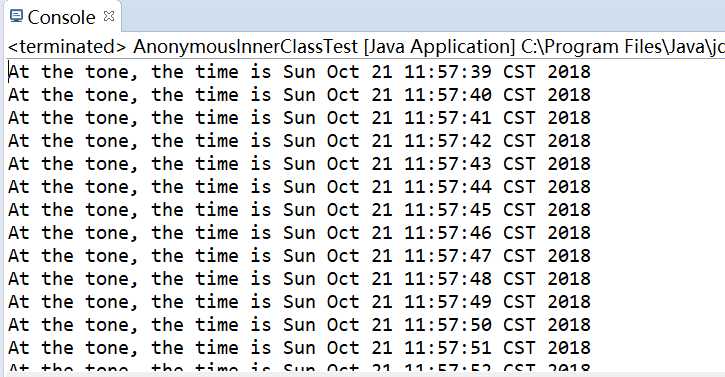
实验程序3:
l 在elipse IDE中调试运行教材257页-258页程序6-9,结合程序运行结果理解程序;
l 了解静态内部类的用 1 package staticInnerClass;
2 3 /** 4 * This program demonstrates the use of static inner classes. 5 * @version 1.02 2015-05-12 6 * @author Cay Horstmann 7 */ 8 public class StaticInnerClassTest 9 { 10 public static void main(String[] args) 11 { 12 double[] d = new double[20]; 13 for (int i = 0; i < d.length; i++) 14 d[i] = 100 * Math.random(); 15 ArrayAlg.Pair p = ArrayAlg.minmax(d); 16 System.out.println("min = " + p.getFirst()); 17 System.out.println("max = " + p.getSecond()); 18 } 19 } 20 21 class ArrayAlg 22 { 23 /** 24 * A pair of floating-point numbers 25 */ 26 public static class Pair 27 { 28 private double first; 29 private double second; 30 31 /** 32 * Constructs a pair from two floating-point numbers 33 * @param f the first number 34 * @param s the second number 35 */ 36 public Pair(double f, double s) 37 { 38 first = f; 39 second = s; 40 } 41 42 /** 43 * Returns the first number of the pair 44 * @return the first number 45 */ 46 public double getFirst() 47 { 48 return first; 49 } 50 51 /** 52 * Returns the second number of the pair 53 * @return the second number 54 */ 55 public double getSecond() 56 { 57 return second; 58 } 59 } 60 61 /** 62 * Computes both the minimum and the maximum of an array 63 * @param values an array of floating-point numbers 64 * @return a pair whose first element is the minimum and whose second element 65 * is the maximum 66 */ 67 public static Pair minmax(double[] values) 68 { 69 double min = Double.POSITIVE_INFINITY; 70 double max = Double.NEGATIVE_INFINITY; 71 for (double v : values) 72 { 73 if (min > v) min = v; 74 if (max < v) max = v; 75 } 76 return new Pair(min, max); 77 } 78
运行结果如下:
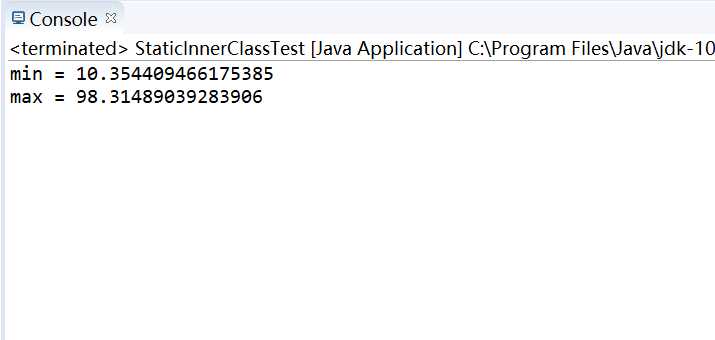
4. 实验总结:
通过本次实验我掌握了接口定义方法;掌握了实现了接口类的定义要求;掌握了实现了接口类的使用要求; 掌握了程序回调设计模式;掌握了Comparator接口用法;掌握了对象浅层拷贝与深层拷贝方法;掌握了Lambda表达式语法;了解了内部类的用途及语法要求。
以上是关于杨玲 201771010133《面向对象程序设计(java)》第八周学习总结的主要内容,如果未能解决你的问题,请参考以下文章